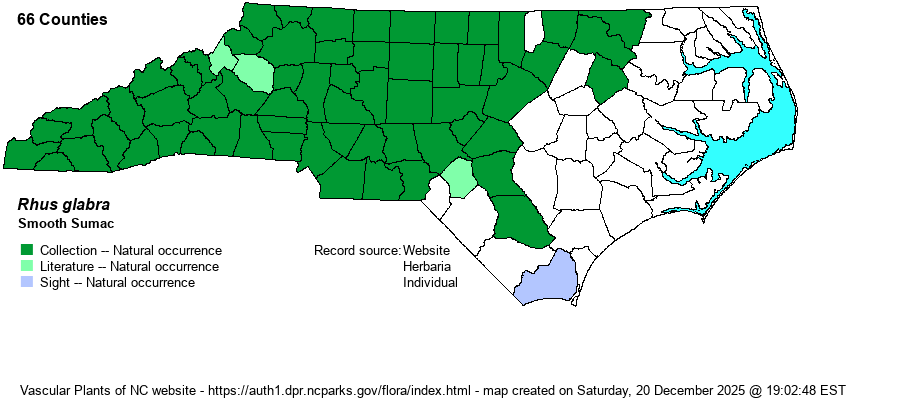| Author | L. | |
| Distribution | Throughout the Mountains and Piedmont, and the extreme western Coastal Plain (including the Sandhills). Absent from essentially all of the eastern 2/3rds of the Coastal Plain. It does occur in counties in southeastern VA, and thus could occur in extreme northeastern NC.
A wide-ranging species from the Atlantic to the Pacific; ranging north to southern Canada and south to the Gulf Coast. Found in all 50 states, though scarce in the South Atlantic Coastal Plain.
| |
| Abundance | In the Mountains and Piedmont, it is fairly common to common, though much less numerous than is Rhus copallinum. Generally rare to uncommon in the Coastal Plain portion of the range. It is typically not seen by the biologist on a daily basis, as is the latter species. | |
| Habitat | Like Rhus copallinum, this is a species of a wide range of sunny habitats, and like that species occurring most often in old fields, thickets, powerline clearings, and fencerows. It also occurs in open woods to a lesser extent. Both species may be found in close proximity. |
| Phenology | Blooms from late May to July; fruits from June to October. | |
| Identification | This is a fairly tall deciduous shrub, to small tree, growing to about 10 feet tall, rarely to 15 feet. It has alternate, pinnate leaves, with more leaflets than R. copallinum, and the leaflets (15-31) are serrate and not entire. There are no wings on the leaf petiole. The leaflets average 3-4 inches long and are whitish below. The branches are smooth, which distinguishes the species from the quite similar (but more montane) R. typhina. It has the typical tall sumac inflorescence of very numerous small yellow flowers in a large terminal panicle, followed by red “berries”. Away from the mountains, the species should be readily identified at some distance, as the leaflets are not shiny and there are no “wings”; closer examination is needed in the mountains and foothills. However, the species may occasionally hybridize with R. copallinum. | |
| Taxonomic Comments | None
| |
| Other Common Name(s) | None | |
| State Rank | S5 | |
| Global Rank | G5 | |
| State Status | | |
| US Status | | |
| USACE-agcp | | |
| USACE-emp | | |

